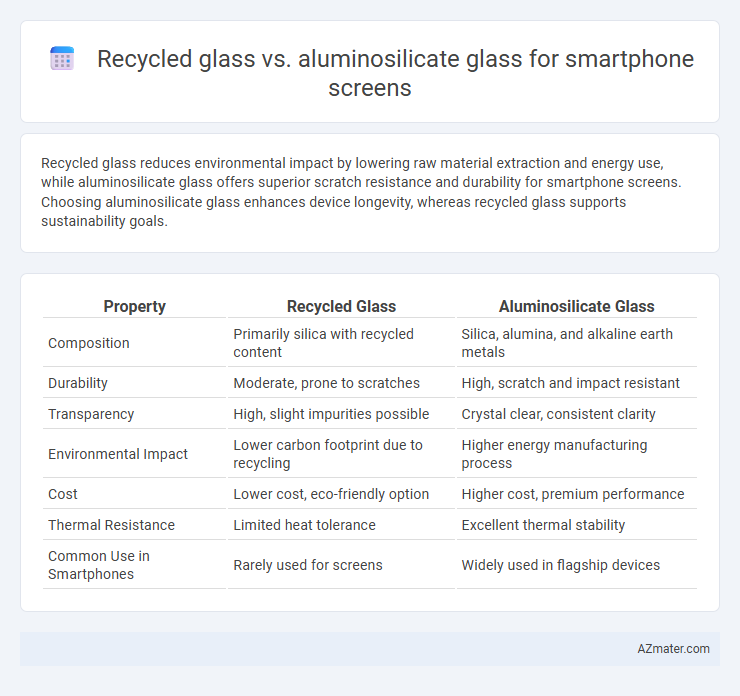Recycled glass reduces environmental impact by lowering raw material extraction and energy use, while aluminosilicate glass offers superior scratch resistance and durability for smartphone screens. Choosing aluminosilicate glass enhances device longevity, whereas recycled glass supports sustainability goals.
Table of Comparison
| Property | Recycled Glass | Aluminosilicate Glass |
|---|---|---|
| Composition | Primarily silica with recycled content | Silica, alumina, and alkaline earth metals |
| Durability | Moderate, prone to scratches | High, scratch and impact resistant |
| Transparency | High, slight impurities possible | Crystal clear, consistent clarity |
| Environmental Impact | Lower carbon footprint due to recycling | Higher energy manufacturing process |
| Cost | Lower cost, eco-friendly option | Higher cost, premium performance |
| Thermal Resistance | Limited heat tolerance | Excellent thermal stability |
| Common Use in Smartphones | Rarely used for screens | Widely used in flagship devices |
Introduction to Smartphone Glass Materials
Smartphone screens primarily use aluminosilicate glass due to its exceptional hardness, scratch resistance, and durability, which ensures enhanced device protection. Recycled glass, while environmentally beneficial, often lacks the precise chemical composition and structural integrity required for high-performance smartphone displays. Advances in recycling technology aim to bridge this gap by improving the purity and quality of recycled glass for potential use in premium screen manufacturing.
What is Recycled Glass?
Recycled glass for smartphone screens is made by melting and reforming post-consumer or post-industrial glass waste, reducing environmental impact and conserving raw materials. It maintains essential properties such as transparency and durability but may require advanced processing to match the purity and scratch resistance of aluminosilicate glass. Aluminosilicate glass, used in most modern smartphones, offers superior strength and chemical resistance due to its aluminum and silicon content, making it optimal for high-performance, durable screens.
Understanding Aluminosilicate Glass
Aluminosilicate glass, a chemically strengthened material, offers superior scratch and impact resistance compared to recycled glass, making it ideal for smartphone screens. Its aluminum and silicon oxide composition provides enhanced durability and thermal stability, crucial for protecting sensitive touch displays. This type of glass balances toughness with optical clarity, ensuring both protection and high-resolution screen performance.
Production Processes Compared
Recycled glass for smartphone screens involves melting and reshaping post-consumer glass, reducing raw material extraction and energy consumption by up to 30%, while aluminosilicate glass production requires high-temperature melting of raw materials like silica, alumina, and potassium oxide to create chemically strengthened glass with exceptional scratch resistance. The manufacturing of aluminosilicate glass includes an ion-exchange process, enhancing durability and making it a preferred choice for premium smartphones. In contrast, recycled glass offers environmental benefits and cost savings but may require additional processing to meet the strict purity and performance standards of smartphone displays.
Durability and Scratch Resistance
Recycled glass for smartphone screens offers eco-friendly benefits but generally exhibits lower durability and scratch resistance compared to aluminosilicate glass, which is engineered for enhanced hardness and impact resistance. Aluminosilicate glass, such as Gorilla Glass, features a chemically strengthened surface through ion-exchange processes, significantly improving its ability to withstand scratches, drops, and everyday wear. While recycled glass may reduce environmental impact, aluminosilicate glass remains the industry standard for premium smartphones demanding superior screen protection.
Environmental Impact and Sustainability
Recycled glass reduces the demand for raw materials by reusing existing glass, significantly lowering energy consumption and CO2 emissions during smartphone screen production. Aluminosilicate glass, known for its durability and scratch resistance, often requires intensive mining and processing of raw materials, resulting in a higher environmental footprint. Choosing recycled glass supports circular economy principles and minimizes landfill waste, enhancing sustainability in smartphone manufacturing.
Cost Analysis: Recycled vs Aluminosilicate Glass
Recycled glass offers a cost-effective alternative to aluminosilicate glass for smartphone screens, primarily due to lower raw material and manufacturing expenses. Aluminosilicate glass, known for its superior strength and scratch resistance, commands a higher price point driven by advanced processing techniques and premium quality inputs. While recycled glass reduces overall production costs and promotes sustainability, aluminosilicate glass incurs increased investment in durability and performance, influencing the final cost balance in smartphone screen manufacturing.
Optical Clarity and Touch Sensitivity
Recycled glass for smartphone screens often exhibits slightly reduced optical clarity compared to aluminosilicate glass due to minor impurities and variations in composition. Aluminosilicate glass, engineered with a precise chemical structure, delivers superior light transmission and consistent clarity, enhancing display sharpness. Touch sensitivity is generally higher in aluminosilicate glass, as its smooth, uniform surface enables more accurate capacitive touch response than recycled glass materials.
Market Adoption in Smartphone Brands
Aluminosilicate glass dominates the smartphone market due to its superior scratch resistance and durability, with brands like Apple and Samsung standardizing its use across flagship models. Recycled glass, while environmentally sustainable, struggles to gain widespread adoption as it often lacks the high strength and clarity required by premium devices. Market adoption trends indicate that leading smartphone manufacturers prioritize performance and user experience over eco-friendly materials, limiting recycled glass integration primarily to niche or budget segments.
Future Trends in Smartphone Screen Glass
Recycled glass is gaining traction in smartphone screens due to its lower environmental impact and potential cost savings, while aluminosilicate glass remains preferred for its superior strength, scratch resistance, and durability. Future trends emphasize enhancing aluminosilicate glass formulations with nano-coatings and ion-exchange treatments to improve toughness and reduce weight. Innovations in integrating sustainable recycled glass without compromising performance are advancing, aiming to balance eco-friendliness with the high reliability demanded by modern smartphone displays.

Infographic: Recycled glass vs Aluminosilicate glass for Smartphone screen
 azmater.com
azmater.com